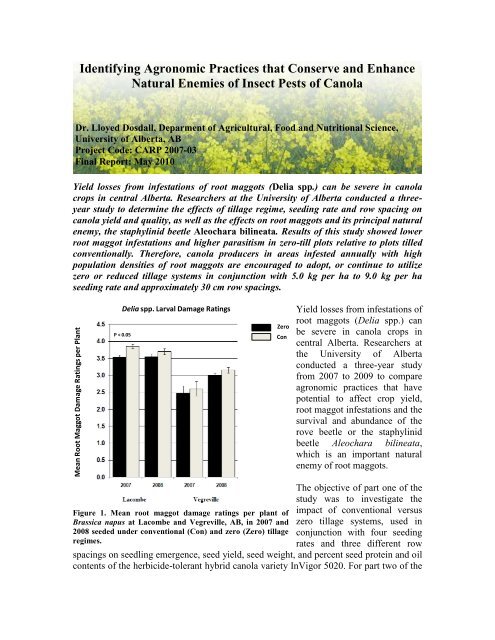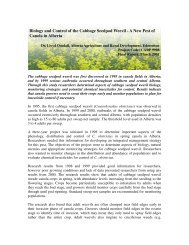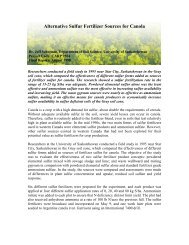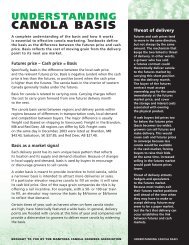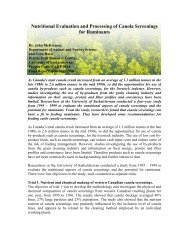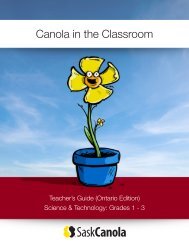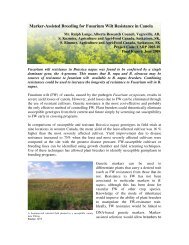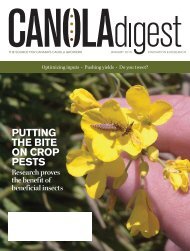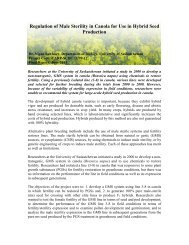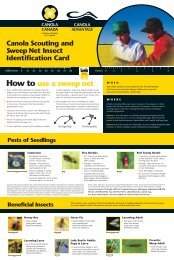Identifying Agronomic Practices that Conserve and ... - SaskCanola
Identifying Agronomic Practices that Conserve and ... - SaskCanola
Identifying Agronomic Practices that Conserve and ... - SaskCanola
You also want an ePaper? Increase the reach of your titles
YUMPU automatically turns print PDFs into web optimized ePapers that Google loves.
Mean Root Maggot Damage Ratings per Plant<strong>Identifying</strong> <strong>Agronomic</strong> <strong>Practices</strong> <strong>that</strong> <strong>Conserve</strong> <strong>and</strong> EnhanceNatural Enemies of Insect Pests of CanolaDr. Lloyed Dosdall, Deparment of Agricultural, Food <strong>and</strong> Nutritional Science,University of Alberta, ABProject Code: CARP 2007-03Final Report: May 2010Yield losses from infestations of root maggots (Delia spp.) can be severe in canolacrops in central Alberta. Researchers at the University of Alberta conducted a threeyearstudy to determine the effects of tillage regime, seeding rate <strong>and</strong> row spacing oncanola yield <strong>and</strong> quality, as well as the effects on root maggots <strong>and</strong> its principal naturalenemy, the staphylinid beetle Aleochara bilineata. Results of this study showed lowerroot maggot infestations <strong>and</strong> higher parasitism in zero-till plots relative to plots tilledconventionally. Therefore, canola producers in areas infested annually with highpopulation densities of root maggots are encouraged to adopt, or continue to utilizezero or reduced tillage systems in conjunction with 5.0 kg per ha to 9.0 kg per haseeding rate <strong>and</strong> approximately 30 cm row spacings.Delia spp. Larval Damage RatingsP < 0.05 P < 0.05ZeroConYield losses from infestations ofroot maggots (Delia spp.) canbe severe in canola crops incentral Alberta. Researchers atthe University of Albertaconducted a three-year studyfrom 2007 to 2009 to compareagronomic practices <strong>that</strong> havepotential to affect crop yield,root maggot infestations <strong>and</strong> thesurvival <strong>and</strong> abundance of therove beetle or the staphylinidbeetle Aleochara bilineata,which is an important naturalenemy of root maggots.Figure 1. Mean root maggot damage ratings per plant ofBrassica napus at Lacombe <strong>and</strong> Vegreville, AB, in 2007 <strong>and</strong>2008 seeded under conventional (Con) <strong>and</strong> zero (Zero) tillageregimes.The objective of part one of thestudy was to investigate theimpact of conventional versuszero tillage systems, used inconjunction with four seedingrates <strong>and</strong> three different rowspacings on seedling emergence, seed yield, seed weight, <strong>and</strong> percent seed protein <strong>and</strong> oilcontents of the herbicide-tolerant hybrid canola variety InVigor 5020. For part two of the
Percent Parasitismstudy, the objective was to investigate the effects of tillage regime, seeding rate, <strong>and</strong> rowspacing on infestations of Delia spp. <strong>and</strong> population density <strong>and</strong> parasitism of thepredator-parasitoid A. bilineata.The study was Parasitism of Aleochara bilineata on Delia spp. Pupariaconducted at twosites in centralAlberta,ZeroConLacombe <strong>and</strong>Vegreville. Plotswere seeded toP < 0.05barley in theyears precedingthe study. Thezero-tillage plotswere seededdirectly into thecereal stubblewith minimalSite - Yearsdisturbance ofthe surface cropresidue. Theconventionalat Lacombe <strong>and</strong> Vegreville, AB in 2007 <strong>and</strong> 2008.tillage plots were worked with at least two cultivations to a depth of approximately 8 cmprior to seeding. Plots at Lacombe were seeded with a Conserva Pak® no-till drillwhereas plots at Vegreville were seeded with a double-disc no-till drill.Figure 8. Mean percent parasitism of Aleochara bilineata on Delia spp. pupariain Brassica napus plots seeded under conventional (Con) <strong>and</strong> zero (Zero) tillageRow spacings used in the study were 22, 30, <strong>and</strong> 45 cm, <strong>and</strong> seeding rates were 2.5, 5.0,7.5, <strong>and</strong> 10.0 kg per ha. Seed number was adjusted for each seeding rate <strong>and</strong> row spacingto achieve target canola densities of 60, 120, 180, <strong>and</strong> 240 plants per square meter. Foreach plot, plant emergence counts, canola seed yield, 1,000 kernel weight, <strong>and</strong> canolaseed oil <strong>and</strong> seed protein contents were collected. In addition, assessments of root maggotoviposition, root maggot damage ratings, rove beetle activity density <strong>and</strong> parasitismlevels on root maggot puparia were also conducted.The study results showed <strong>that</strong> the predator-parasitoid A. bilineata is important forreducing populations of root maggots in canola in central Alberta. Parasitism rates of 38to 74% were found for Delia spp. puparia <strong>and</strong> in some site-years large numbers of adultsindicated vast numbers of root maggot eggs were removed by these insects. In general,there was a higher percentage of parasitism of Delia spp. by A. bilineata observed in zerothan in conventional tillage. There were no consistent effects observed on A. bilineataactivity in relation to seeding rate <strong>and</strong> row spacing.The study also found canola yields in relation to seeding rate <strong>and</strong> row spacing to bevariable. The research found no evidence to conclude <strong>that</strong> tillage regime had a significanteffect on canola seed yield. However, the research showed <strong>that</strong> adopting zero or reduced
tillage in conjunction with a recommended seeding rate of at least 5.6 kg to 9.0 kg per ha<strong>and</strong> row spacing of 30 cm will bring advantages in terms of improved management ofroot maggots <strong>and</strong> other important canola pests like flea beetles <strong>and</strong> weeds, while helpingmaintain reasonably good seed yields. Canola producers in areas infested annually withhigh population densities of root maggots are encouraged to adopt, or continue to utilizezero or reduced tillage systems because results of this study showed lower root maggotinfestations <strong>and</strong> higher parasitism in zero-till plots relative to plots tilled conventionally.


